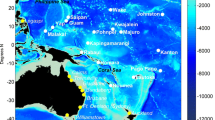Summary
The S1 tidal wave arising from the second order tidal potential occurs in any geophysical data record. Since the frequency of S1 is the same as that of earth’s rotation, many distortions are observed in real data sets. To isolate S1 from its powerful neighbours,K 1 and P1 at least one-year hourly data series are required. Studies onS 1 on an experimental basis, have been aimed mainly at a precise determination of its origin and mechanisms of variability. There are many hypotheses on its variability. In physical oceanography it is commonly accepted that the variability of S1 is due to air-sea interaction processes. The authors review most existing hypotheses on the variability of S1 They also show that the distortions of real data must be expected due to additional contributions from the second and third-order lunar potentials. An analysis is made to detect the sources of the additional contributions to the S1 frequency.
Zusammenfassung
Die Gezeitenwelle (Partialtide) S1 ist in jedem Datensatz gegenwärtig, der unter dem Einfluβ der Gezei tenkräfte aufgezeichnet wurde. Ihre Quelle ist das sonnentägliche Gezeitenpotential zweiter Ordnung. Die Frequenz S1 stimmt mit der der Erdrotation überein. In den beobachteten Datensätzen treten aber viele Stö rungen auf. Wenigstens ein Jahr stündlicher Beobachtungen ist erforderlich, um die S1 von ihren beiden mächtigen Nachbarn, nämlich derK 1 und P1 ,trennen zu können. In längeren Beobachtungsreihen tritt sie klar in Erscheinung. Viele Arbeiten über die S1 haben sich damit beschäftigt, ihren Ursprung und die Quelle ihrer Verände rung genau zu bestimmen. Es wurden aber auch viele Hypothesen hinsichtlich der in den Beobachtungen vorgefundenen Störungen aufgestellt. In dieser Arbeit wird eine neue Hypothese, die Veränderlichkeit der S1 betreffend, aufgezeigt, deren Grundlage die theoretische Entwicklung “TIPAB-95” des gezeitenerzeugenden Potentials ist.
Similar content being viewed by others
References
Alonso, J. J., 1996: Desarrollo Semianalitico del Potencial Generador de Marea y Variabilidad de las Estimas Armónicas de las Componentes de Marea Teórica. Ph. D. Thesis. University of Cádiz.
Alonso, J. J., M. Bruno, R. Mananes, 1996: Semianalytical Ephemeris and The Tide Generating Potential TIPAB-95.Bulletin de Information de Mareés Terre stres,124, March 1996, 9417–9424.
Bretagnon, P., 1982: Théorie du mouvement de l’en semble des planétes. Solution VSOP-82,Astron. and Astrophys.,114, 278–288.
Bruno, M., 1993: Un análisis de las causas que contribuyen a la distorsión de la señal semidiurna de marea en la costa Este de la Isla de Gran Canaria, Ph. D. Thesis, Universidad de Cádiz.
Büllesfeld andSchuh, 1985: New harmonic develop ment of the Tide Generating Potential ETMB85 with ap plications on VLBI data analysis. Proc. of the Tenth Int. Symp. of Earth Tides.
Cartwright, D. E. andR. J. Tayler, 1971: New compu tations of the Tide-generating Potential.Geophys. J. R. Astr. Soc,22, 45–74.
Cartwright, D. E. andA. C. Edden, 1973: Corrected ta bles of Tidal harmonics,Geophys. J. R. Astr. Soc,33, 253–264.
Chapront, J. andM. Chapront-Touzé, 1982: Planetary perturbations of the Moon in ELP-2000.Celestial Me chanics,26, 83–94.
Chapront-Touzé, M. andJ. Chapront, 1983: The lunar ephemeris ELP-2000.Astron. and Astrophys.,124, 50–62.
Chapront-Touzé, M., 1982: The ELP solution for the main problem of the Moon and some applications.Celestial Mechanics,26, 63–69.
De Toro y Llaca, C, 1989: Determinación y evaluaeión de las desviaciones periódicas de la gravedad y de las desviaciones de la vertical en la Peninsula Ibérica pro-ducidas por las mareas oceánicas. Tesis Doctoral. Univ. Complutense. Madrid.
Doodson, A. T., 1921: The harmonic development of the tide generating potential.Proc. Roy. Soc. London, Series A,100, 306–308.
Foreman, M. G. G., 1977: Manual for tidal heights analysis and prediction. Inst. Ocean Sci., Victotia, B. C, Pacific. Mar. Sci., Rep. 77–10.
Getino, J., 1995a: An Interpretation of the Core Mantle Interaction Problem, Geophys. J. Int., 120, 693–705.
Getino, J., 1995b: Forced Nutations of a Rigid Mantle - Liquid Core Earth Model in Canonical Formulation.Geophys. J. Int.,122, 803–814.
Getino, J. andJ. M. Ferrándiz, 1995: On the Effect of the Mantle Elasticity on the Earth Rotation.Celest Mech. Dynam.Astr.,61, 117–180.
Godin, G., 1972: The Analysis of Tides, Univ. of Toronto Press.
Godin, G., 1990: S1 a small by perplexing component of the tide.Dt. hydrogr. Z,43.
Godin, G., 1995: personal communication.
Godin, G., A. Martínez, 1994: Numerical Experiments To Investigate the Effects of Quadratic Friction on the Propagation of Tides in a Channel.Cont. Sh. Res.,14, 7/8, 723–748.
Hartmann andWenzel, 1994: Catalogue of the Earth Tide Generating Potential due to the planets.Bull. Inf. Mareés Terrestres,119, pp 8847–8880.
Marone, E., 1996: Radiational Tides as Nonlinear Effects: Bispectral Interpretation.Cont. Sh. Res.,16, 8, 1117–1126.
Melchior, P., 1983: The Tides of the planet Earth. 2nd Ed., Pergamon Press.
Moritz, H. andI.I. Muller, 1987: Earth Rotation: Theory and Practice, Ungar Ed.
Pekeris andAccad, 1972: Dynamics of the liquid core of the Earth, Phil.Trans. Royal Soc. London,A273, 1233/1972, 237–260.
Pugh, D. T., 1987: Tides, surges and mean sea level, John Wiley and Sons.
Roosbeek, F., 1995: A tide generating potential at nanogal level. Bull. Inf. Mareés Terrestres, 121, pp 9032-9035.
Sevilla, M. andP. Romero, 1987: Polar Motion for an Elastic Earth Model with a Homogeneous Liquid Core using Canonical Theory.Bull. Geod,61, 1–20.
Standish, E. M., 1982: The JPL planetary ephemerides.Celestial Mechanics,26, 181–186.
Standish, E. M., 1997: personal communication.
Tamura, Y., 1987: A Harmonic development of the Tide Generating Potential. Marees Terrestres.Bulletin d’informations.99, 6813–6855.
Tejedor, B., 1991: Fenómenos dinámicos de interacción atmósfera océano. Tesis Doctoral, Univ. de Las Palmas.
Venedikov, A. P., R. Vieira, yC. de Toro, 1992:A new method for earth tide analysis, Instituto Nacional de Astronomía y Geodesia, CSIC-UCM, Publicación nℴ 183, Madrid.
Venedikov, A. P., 1995: personal notes.
Xi Qinwen, 1985: The algebraic deduction of Harmonic Development of the Tide Generating Potential with the IBM-PC, Proc. of the Tenth Int. Symp. of Earth Tides.
Xi Qinwen, 1987: A new complete development of the Tide Generating Potential for the epoch J2000.0. Marees Terrestres.Bulletin d’informations.99, 6786–6812.
Author information
Authors and Affiliations
Rights and permissions
About this article
Cite this article
Alonso, J.J., Bruno, M. & Mañanes, R. Theoretical variability of s1 in the tide generating potential. Deutsche Hydrographische Zeitschrift 49, 457–466 (1997). https://doi.org/10.1007/BF02764340
Received:
Accepted:
Published:
Issue Date:
DOI: https://doi.org/10.1007/BF02764340




